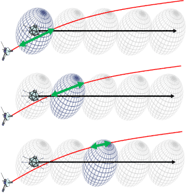Number of Encounters Assessment Tool
The Number of Encounters Assessment Tool (NEAT) assesses collision risk by adjusting key parameters including constellation size, orbit altitude, and inclination. Users can also customize their threshold for warnings, maneuvers, and hard-body collisions.
Average encounters per 1 day:
Warnings: 4.631
Maneuvers: 0.515
Collisions: 1.29e-005

3 March 2025 : Spacecraft encounter rates vs inclination and altitude
(5 km altitude and 5 deg inclination grid)
Copyright COMSPOC Corporation, All Rights Reserved
How does it work?
NEAT uses a fast, probability-based algorithm to assess the long-term encounter rate between any and all pairs of satellites. Here, the term “encounter” is a generic term to denote a close approach event; by specifying the miss distance of interest, the user can make the “encounter” represent a hard-body collision, or a maneuver, or a warning.
This algorithm works by defining a path-centered ring torus about a second satellite’s orbit and assessing if/when the first satellite’s orbit penetrates this torus. The green arrows show the first satellite’s range of true anomaly for a specific orbital position of the second satellite.

The position of each object is assumed to be uniformly distributed in mean anomaly along its orbit in order to determine the probability of both objects being within a user-specified distance. It is suitable for all circular, elliptical, and relatively-inclined orbits. This method was used to effectively assess the impact of proposed constellations on encounter rates.
**The publicly-available version of the NEAT tool is limited to circular orbits of the satellite(s) of interest.
Alfano, S and Oltrogge, D.L., “Volumetric Assessment of Encounter Probability,” Acta Astronautica 2018, https://doi.org/10.1016/j.actaastro.2018.09.030, 1 October 2018.
Alfano, S., Oltrogge, D.L., and Shepperd, R., “LEO constellation encounter and collision rate estimation: An update,” 2nd IAA Conference on Space Situational Awareness, IAA-ICSSA-20-0021, 14 January 2020.
D.L. Oltrogge, S. Alfano, C. Law, A. Cacioni, T.S. Kelso, “A comprehensive assessment of collision likelihood in Geosynchronous Earth Orbit,”Acta Astronautica (2018), doi:10.1016/j.actaastro.2018.03.017.
